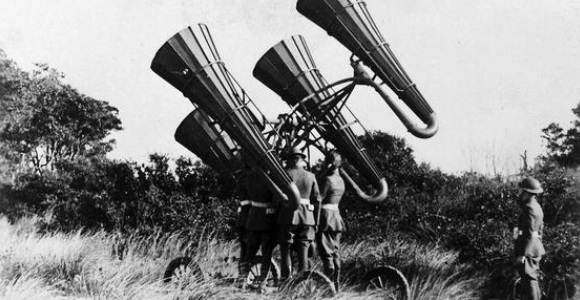jjDESIGNS DEALER NEWS UPDATE JUNE 16th 2018
PREVIEWED AT THE ONTARIO MODEL SOLDIER SOCIETY ANNUAL SHOW IN TORONTO ON 16th JUNE 2018
NEW FOR KNIGHTS OF THE SKIES
Many thanks to Scott Dummitt and the Canadian War Museum for their help in reproducing this unique piece of Great War technology.
2 Figures to accompany this item will also be available.
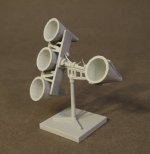
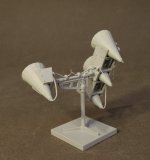
Acoustic Location devices were used by military services from mid-WW1 to the early years of WW2 for the passive detection of approaching enemy aircraft by listening for the noise of their engines. These typically consisted of large acoustic horns attached to stethoscope-type earphones worn by monitors.
The first use of this type of equipment was claimed by commander Alfred Rawlinson of the Royal Naval Volunteer Reserve, who in the autumn of 1916 was commanding a mobile anti-aircraft battery on the east coast of England. He needed a means of locating Zeppelins during cloudy conditions and improvised an apparatus from a pair of gramophone horns mounted on a rotating pole. Several of these pieces of equipment were able to give a fairly accurate fix on the approaching airships, allowing the guns to be directed at them despite being out of sight.
Although no hits were ever recorded by using this method, Rawlinson claimed to have forced a Zeppelin to jettison its bombs on one occasion.
Tubes connected the bases of two horizontal, gramophone-style horns to a pair of stethoscope earpieces. An operator moved the detector until he heard sound equally in each ear, at which point, ideally, the guns could be pointed in the direction of the aircraft. The two vertical cones estimated the target's height.
Improved forms of this instrument were still in use in 1939-1940, before being superseded by radar. Extract from Canadian War Museum website:
“The Mk 1 Sound Locator was manufactured by A.W. Gamage Ltd. in Britain during the first World War. In the early days of the First World War, anti-aircraft defence was a totally new field. The detection of unseen incoming aircraft was a major problem. The only possible solution with the technology available at the time was sound detectors, which could provide a rough idea of an aircraft's direction and height based upon the sound of its engine. Tubes connected the bases of two horizontally mounted gramophone-style horns to a pair of stethoscope earpieces. An operator moved the detector until the sound was heard equally in each ear, at which point (theoretically) it would be pointed in the direction of the aircraft. A second operator used the vertically mounted horns to estimate height. The system was rudimentary at best, however, as the location of the aircraft could only be established for the time that the sound was recorded. After a sound contact was made, laborious calculations were then required to properly aim an anti-aircraft gun, and any deviation in the aircraft's flight path rendered the system useless. It was, however, the only system available for detecting the approach of unseen aircraft until the development of radar in the 1930s.”
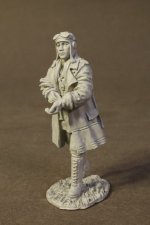
Raymond Collishaw, CB, DSO & Bar, OBE, DSC, DFC (22 November 1893 – 28 September 1976) was a distinguished Canadian fighter pilot, squadron leader, and commanding officer who served in the Royal Naval Air Service (RNAS) and later the Royal Air Force. He was the highest scoring RNAS flying ace and the second highest scoring Canadian pilot of the First World War. He was noted as a great leader in the air, leading many of his own formations into battle.
By the end of May, the Royal Flying Corps was badly in need of reinforcements, much due to the after-effects of Bloody April. As a result, Collishaw was posted to his previous No. 10 Naval Squadron as a flight commander.
Collishaw's "B" Flight would be composed entirely of Canadians.
Although British commanders had strongly discouraged pilots painting their aircraft, Collishaw's flight painted their Sopwith Triplanes black (though appearing dark brown), and called themselves the All-Black Flight, later known more simply as the Black Flight
The aircraft of the All-Black Flight were christened with suitable names.
Ellis Reid, of Toronto, flew Black Roger; J. E. Sharman, of Winnipeg, flew Black Death; Gerry Nash, of Hamilton, called his machine Black Sheep; and Marcus Alexander, of Toronto, christened his plane the Black Prince. The flight commander, Raymond Collishaw, flew a machine which gloried in the name Black Maria
During their first two months they claimed a record 87 German aircraft destroyed or driven down – which, strangely enough, brought Collishaw and the unit no wide publicity, though garnered a great deal of renown among their German opponents in the area. Collishaw later claimed that this was because officials in the regular Royal Flying Corps were loath to give credit to naval pilots.
June 6, 1917 was their grandest day. They were flying offensive patrols with 10 Triplanes. Collishaw was leading a patrol when they came across an Albatros 2-seater escorted by 15 Albatros and Halberstadt fighters. In the "fur ball" that ensued Collishaw dropped three Albatros’s, Nash downed an Aviatik two-seater and an Albatros, Reid downed a Halberstadt scout, Sharman and Alexander each downed an Albatros. In total the RNAS shot down 10 German aircraft without any losses.
NEW FOR ARMIES AND ENEMIES OF ANCIENT ROME
Many thanks to David Gaultier from Quebec’s Artisans Toy Soldiers Club, who also attended the Ontario show.
Displayed on their table were prototypes of 9 new Germanic Warriors.
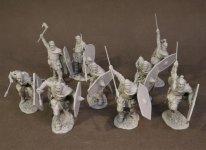
ANCIENT GERMANIC WARRIORS
Following two decades of Roman occupation, Germania Magna erupted into revolt in AD 9, resulting in the stunning loss of three Roman legions to an alliance of Germanic nations at Teutoburg. The Battle of the Teutoburg Fores, described as the Varian Disaster by Roman historians, took place in the Teutoburg Forest in 9 CE, when an alliance of Germanic tribes ambushed and decisively destroyed three Roman legions and their auxiliaries, led by Publius Quinctilius Varus.
The alliance was led by Arminius, a Germanic officer of Varus' auxilia. Arminius had acquired Roman citizenship and had received a Roman military education, which enabled him to deceive the Roman commander methodically and anticipate the Roman army's tactical responses.
Despite several successful campaigns and raids by the Romans in the years after the battle, they never again attempted to conquer the Germanic territories east of the Rhine river. The victory of the Germanic tribes against Rome's legions in the Teutoburg Forest would have far-reaching effects on the subsequent history of both the ancient Germanic peoples and the Roman Empire. Contemporary and modern
historians have generally regarded Arminius' victory over Varus as "Rome's greatest defeat", one of the most decisive battles recorded in military history, and as "a turning-point in world history"
The Cherusci nation, was a Germanic tribe that fought at the Teutoburg Pass, Weser River, Idistaviso and the Agrivarian Wall under its war chief Arminius. These warriors were perfectly equipped for the Germanic landscape of open fields, forests and swamps. The weapons which were used included the long lance or Framea, which could be swung, thrust or thrown at an opponent.
Hair was grown long and often tied up in a figure of eight or “Suebian” knot.
In the Cherusci warrior the Roman Legionary met a formidable opponent. The Germanic warrior was a well trained, battle-hardened, combat ready and motivated fighter, who excelled in irregular warfare, ambushes, raids and petty warfare. In an ambush the lightly armed Germanic fighter could decisively defeat a heavily equipped legionary by using surprise and the terrain to his advantage.
In a set-piece battle the German could stand up to the Roman Legionary discipline and formations for a while, but in close quarters combat the advantage eventually shifted to the legionary, as at the Battle of Idistaviso, and the Angrivarian Wall.
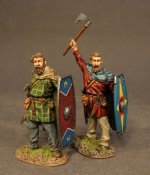
The first Germanic Warriors as well as the first of the Iceni Celtic warriors should be available from September.
**PLEASE NOTE THE FIRST OF THE SPANISH CONQUISTADORS WILL BE PREVIEWED AT THE GREY GOOSE COLLECTIBLES STAND, AT THE LONDON TOY SOLDIER SHOW ON SATURDAY 30th JUNE 2018**
PREVIEWED AT THE ONTARIO MODEL SOLDIER SOCIETY ANNUAL SHOW IN TORONTO ON 16th JUNE 2018
NEW FOR KNIGHTS OF THE SKIES
Many thanks to Scott Dummitt and the Canadian War Museum for their help in reproducing this unique piece of Great War technology.
2 Figures to accompany this item will also be available.


Acoustic Location devices were used by military services from mid-WW1 to the early years of WW2 for the passive detection of approaching enemy aircraft by listening for the noise of their engines. These typically consisted of large acoustic horns attached to stethoscope-type earphones worn by monitors.
The first use of this type of equipment was claimed by commander Alfred Rawlinson of the Royal Naval Volunteer Reserve, who in the autumn of 1916 was commanding a mobile anti-aircraft battery on the east coast of England. He needed a means of locating Zeppelins during cloudy conditions and improvised an apparatus from a pair of gramophone horns mounted on a rotating pole. Several of these pieces of equipment were able to give a fairly accurate fix on the approaching airships, allowing the guns to be directed at them despite being out of sight.
Although no hits were ever recorded by using this method, Rawlinson claimed to have forced a Zeppelin to jettison its bombs on one occasion.
Tubes connected the bases of two horizontal, gramophone-style horns to a pair of stethoscope earpieces. An operator moved the detector until he heard sound equally in each ear, at which point, ideally, the guns could be pointed in the direction of the aircraft. The two vertical cones estimated the target's height.
Improved forms of this instrument were still in use in 1939-1940, before being superseded by radar. Extract from Canadian War Museum website:
“The Mk 1 Sound Locator was manufactured by A.W. Gamage Ltd. in Britain during the first World War. In the early days of the First World War, anti-aircraft defence was a totally new field. The detection of unseen incoming aircraft was a major problem. The only possible solution with the technology available at the time was sound detectors, which could provide a rough idea of an aircraft's direction and height based upon the sound of its engine. Tubes connected the bases of two horizontally mounted gramophone-style horns to a pair of stethoscope earpieces. An operator moved the detector until the sound was heard equally in each ear, at which point (theoretically) it would be pointed in the direction of the aircraft. A second operator used the vertically mounted horns to estimate height. The system was rudimentary at best, however, as the location of the aircraft could only be established for the time that the sound was recorded. After a sound contact was made, laborious calculations were then required to properly aim an anti-aircraft gun, and any deviation in the aircraft's flight path rendered the system useless. It was, however, the only system available for detecting the approach of unseen aircraft until the development of radar in the 1930s.”

Raymond Collishaw, CB, DSO & Bar, OBE, DSC, DFC (22 November 1893 – 28 September 1976) was a distinguished Canadian fighter pilot, squadron leader, and commanding officer who served in the Royal Naval Air Service (RNAS) and later the Royal Air Force. He was the highest scoring RNAS flying ace and the second highest scoring Canadian pilot of the First World War. He was noted as a great leader in the air, leading many of his own formations into battle.
By the end of May, the Royal Flying Corps was badly in need of reinforcements, much due to the after-effects of Bloody April. As a result, Collishaw was posted to his previous No. 10 Naval Squadron as a flight commander.
Collishaw's "B" Flight would be composed entirely of Canadians.
Although British commanders had strongly discouraged pilots painting their aircraft, Collishaw's flight painted their Sopwith Triplanes black (though appearing dark brown), and called themselves the All-Black Flight, later known more simply as the Black Flight
The aircraft of the All-Black Flight were christened with suitable names.
Ellis Reid, of Toronto, flew Black Roger; J. E. Sharman, of Winnipeg, flew Black Death; Gerry Nash, of Hamilton, called his machine Black Sheep; and Marcus Alexander, of Toronto, christened his plane the Black Prince. The flight commander, Raymond Collishaw, flew a machine which gloried in the name Black Maria
During their first two months they claimed a record 87 German aircraft destroyed or driven down – which, strangely enough, brought Collishaw and the unit no wide publicity, though garnered a great deal of renown among their German opponents in the area. Collishaw later claimed that this was because officials in the regular Royal Flying Corps were loath to give credit to naval pilots.
June 6, 1917 was their grandest day. They were flying offensive patrols with 10 Triplanes. Collishaw was leading a patrol when they came across an Albatros 2-seater escorted by 15 Albatros and Halberstadt fighters. In the "fur ball" that ensued Collishaw dropped three Albatros’s, Nash downed an Aviatik two-seater and an Albatros, Reid downed a Halberstadt scout, Sharman and Alexander each downed an Albatros. In total the RNAS shot down 10 German aircraft without any losses.
NEW FOR ARMIES AND ENEMIES OF ANCIENT ROME
Many thanks to David Gaultier from Quebec’s Artisans Toy Soldiers Club, who also attended the Ontario show.
Displayed on their table were prototypes of 9 new Germanic Warriors.

ANCIENT GERMANIC WARRIORS
Following two decades of Roman occupation, Germania Magna erupted into revolt in AD 9, resulting in the stunning loss of three Roman legions to an alliance of Germanic nations at Teutoburg. The Battle of the Teutoburg Fores, described as the Varian Disaster by Roman historians, took place in the Teutoburg Forest in 9 CE, when an alliance of Germanic tribes ambushed and decisively destroyed three Roman legions and their auxiliaries, led by Publius Quinctilius Varus.
The alliance was led by Arminius, a Germanic officer of Varus' auxilia. Arminius had acquired Roman citizenship and had received a Roman military education, which enabled him to deceive the Roman commander methodically and anticipate the Roman army's tactical responses.
Despite several successful campaigns and raids by the Romans in the years after the battle, they never again attempted to conquer the Germanic territories east of the Rhine river. The victory of the Germanic tribes against Rome's legions in the Teutoburg Forest would have far-reaching effects on the subsequent history of both the ancient Germanic peoples and the Roman Empire. Contemporary and modern
historians have generally regarded Arminius' victory over Varus as "Rome's greatest defeat", one of the most decisive battles recorded in military history, and as "a turning-point in world history"
The Cherusci nation, was a Germanic tribe that fought at the Teutoburg Pass, Weser River, Idistaviso and the Agrivarian Wall under its war chief Arminius. These warriors were perfectly equipped for the Germanic landscape of open fields, forests and swamps. The weapons which were used included the long lance or Framea, which could be swung, thrust or thrown at an opponent.
Hair was grown long and often tied up in a figure of eight or “Suebian” knot.
In the Cherusci warrior the Roman Legionary met a formidable opponent. The Germanic warrior was a well trained, battle-hardened, combat ready and motivated fighter, who excelled in irregular warfare, ambushes, raids and petty warfare. In an ambush the lightly armed Germanic fighter could decisively defeat a heavily equipped legionary by using surprise and the terrain to his advantage.
In a set-piece battle the German could stand up to the Roman Legionary discipline and formations for a while, but in close quarters combat the advantage eventually shifted to the legionary, as at the Battle of Idistaviso, and the Angrivarian Wall.

The first Germanic Warriors as well as the first of the Iceni Celtic warriors should be available from September.
**PLEASE NOTE THE FIRST OF THE SPANISH CONQUISTADORS WILL BE PREVIEWED AT THE GREY GOOSE COLLECTIBLES STAND, AT THE LONDON TOY SOLDIER SHOW ON SATURDAY 30th JUNE 2018**


